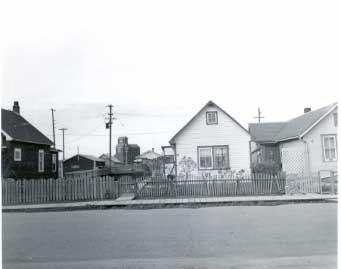
Title and statement of responsibility area
Title proper
Houses in Germantown neighbourhood, Regina
General material designation
- Graphic material
Parallel title
Other title information
Title statements of responsibility
Title notes
Level of description
Item
Repository
Reference code
Edition area
Edition statement
Edition statement of responsibility
Class of material specific details area
Statement of scale (cartographic)
Statement of projection (cartographic)
Statement of coordinates (cartographic)
Statement of scale (architectural)
Issuing jurisdiction and denomination (philatelic)
Dates of creation area
Date(s)
-
ca. 1975 (Creation)
- Place
- Regina (Sask.)
Physical description area
Physical description
1 photograph : b&w ; 10.5 x 13 cm
Publisher's series area
Title proper of publisher's series
Parallel titles of publisher's series
Other title information of publisher's series
Statement of responsibility relating to publisher's series
Numbering within publisher's series
Note on publisher's series
Archival description area
Custodial history
Scope and content
Unidentified houses on a street in the Germantown area of Regina, Saskatchewan.
Notes area
Physical condition
Immediate source of acquisition
Arrangement
Language of material
Script of material
Location of originals
Availability of other formats
Restrictions on access
Terms governing use, reproduction, and publication
Copyright holder: City of Regina
Copyright Expires: 2025
Other terms: The researcher assumes responsibility regarding questions of copyright that may arise in the use of any images.
Finding aids
Associated materials
Accruals
General note
Germantown was the common name for the settlement on the east-side of Regina , along Tenth and Eleventh Avenues near the public market that was set up in 1892. The area was populated by Germans, Hungarians, Romanians, Slavs – basically any ethnic group that was not of Anglo-Saxon descent. The community was home to some of Regina 's more exotic buildings – onion dome churches such as the Romanian Greek Orthodox Church on St. John Street illustrated the character of the community.
Saskatchewan 's population is, and has been from its earliest days, descended primarily from those groups that were often known as “Galicians” – former residents of central and eastern Europe. Regina was no different. Many non-Anglo-Saxon residents chose to immigrate to the city in the early part of the twentieth century.
Members of the German population had arrived in the city during its early years, and by 1913 many of these people owned their own homes and were gainfully employed as businessmen, labourers or tradesmen. They formed thriving community organizations and took advantage of the School Act to ensure that their children received education in German for the last half-hour of the day.
Other non-Anglo-Saxon groups within the city did not fare so well. Residents worked wherever and whenever they could at low-paying jobs. Germantown was the slum area of Regina . Many of the ‘houses' within this 33-block area of east Regina were little more than shacks. There were no water or sewer lines to many of these buildings. These residents of the city had overcrowded or inadequate housing that did not receive regular garbage pickup, and so infectious diseases were rampant in the area. It would be years before these conditions were rectified.
Most residents of this area did not own property thus they did not meet the property qualifications to be added to the municipal voters' lists. Nativistic sentiments among those residents of the city who could vote meant that the miserable lot of many of these people got worse throughout the war years of 1914-1918 as a cloud of suspicion fell on those residents who did not speak English as a first language. Still, there were some people in the community who did not doubt the loyalty of these people during the war years. Mayor Robert Martin was able to veto a recommendation by the commanding officer of the local military, who demanded that armed guards be placed around public utilities and explosives to protect against terrorist actions. Martin informed the commander that while precautions would be taken, no militia was needed because non-English speaking citizens of the city were just as law-abiding as any other residents.

